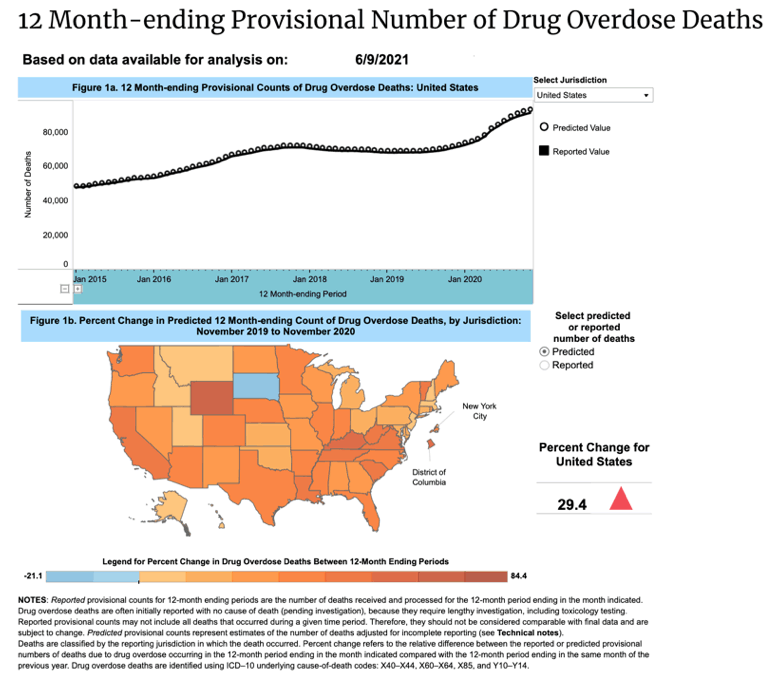| |
Drug Overdoses Increase 30%
|
| |
| |
03 November 2020
Download the PDF here
https://www.cdc.gov/nchs/nvss/vsrr/drug-overdose-data.htm#dashboard
Biden-Harris Administration Calls for Historic Levels of Funding to Prevent and Treat Addiction and Overdose The President's FY2022 $41.0 billion investment for national drug program agencies is a $669.9 million increase over the FY 2021 enacted level.
Early in the pandemic, Ms. Vincent said, the price of street drugs soared. Then drugs being sold as heroin, methamphetamine or cocaine started getting cut with unfamiliar additives. Fentanyl was ever-present - including, increasingly, in counterfeit pills sold as prescription painkillers or anti-anxiety drugs. But so were substances like xylazine, which has been showing up in illicit drugs from Philadelphia to Saskatchewan.
Naloxone is more widespread now, but Ms. Vincent would like to see another lifesaving tool become common: drug-checking programs that would allow people to find out exactly what substances are in illicit drugs before they take them. Such programs exist legally in other countries, including Canada, the Netherlands and New Zealand. Another type of harm reduction program used in other countries - where people use illicit drugs under medical supervision in case they overdose - remains illegal here after a group seeking to open one in Philadelphia has lost in court so far.
https://www.cdc.gov/nchs/nvss/vsrr/drug-overdose-data.htm#dashboard

Helping Drug Users Survive, Not Abstain: 'Harm Reduction' Gains Federal Support
Overdoses have surged during the pandemic. Now, for the first time, Congress has appropriated funds specifically for programs that distribute clean syringes and other supplies meant to protect users.
Published June 27, 2021Updated June 28, 2021
https://www.nytimes.com/2021/06/27/health/overdose-harm-reduction-covid.html
excerpt
GREENSBORO, N.C. - The thin young man quietly took in the room as he waited for the free supplies meant to help him avoid dying: sterile water and cookers to dissolve illicit drugs; clean syringes; alcohol wipes to prevent infection; and naloxone, a medicine that can reverse overdoses. A sign on the wall - "We stand for loving drug users just the way they are" - felt like an embrace.
It was the first day the drop-in center in a residential neighborhood here had opened its doors since the coronavirus forced them shut in the spring of 2020. "I'm so glad you all are open again," the man, whose first name is Jordan, told a volunteer who handed him a full paper bag while heavy metal music riffed over a speaker in the background. He asked for extra naloxone for friends in his rural county, an hour away, where he said it had been scarce throughout the pandemic.
Overdose deaths rose by nearly 30 percent over the 12-month period that ended in November, to more than 90,000, according to preliminary federal data released this month - suggesting 2020 blew past recent records for such deaths. The staggering increase during the pandemic has many contributing factors, including widespread job loss and eviction; diminished access to addiction treatment and medical care; and an illegal drug supply that became even more dangerous after the country essentially shut down.
But the forced isolation for people struggling with addiction and other mental health issues may be one of the biggest. Now, with the nation reopening, the Biden administration is throwing support behind the contentious approach that the center here takes, known as harm reduction. Instead of helping drug users achieve abstinence, the chief goal is to reduce their risk of dying or acquiring infectious diseases like H.I.V. by giving them sterile equipment, tools to check their drugs for fentanyl and other lethal substances, or even just a safe space to nap.
| |
| |
| |
|
|
|